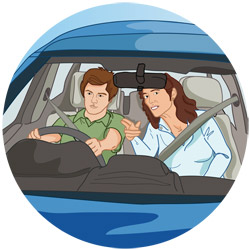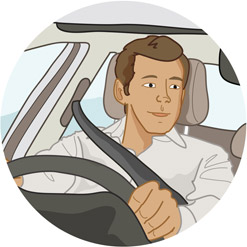During A Practice Drive
Discuss What You Want To Do
Before you set off, discuss with the learner what you want to achieve during the drive. It may be that you want to consolidate existing skills or work on new ones. It is helpful to discuss the skills that your learner needs to work on with the instructor and construct the practice sessions around their advice.
The Driver's Record for Learner Drivers (PDF) is another good way of identifying what skills need to be focused on.

Instructions and Directions
Always give the learner plenty of warning when giving them directions or instructions.
Give instructions and directions well in advance. Be clear and specific.
If they take a wrong turn, suggest ways back to the route, but don't suggest sudden changes of direction or contradict yourself.
The driving test includes about 10 minutes of 'independent driving', during which the learner will be required to follow road signs or a series of directions. Once your learner has gained enough experience, practise independent driving so they gain experience of driving and navigating at the same time without being given step by step instructions on the route. This is much closer to the normal driving conditions they will face after passing their test.
Details of the independent driving part of the driving test are available at www.gov.uk/practical-driving-test-for-cars/independent-driving-section-of-the-test.
Speed
Speed is an important issue for learners. It is one of the major contributory factors in accidents involving young drivers.
When travelling at higher speeds, drivers have less time to identify and react to what is happening around them. It takes longer to stop, and if there is a crash, it is more severe, causing greater injury to those involved, especially to any pedestrian or rider hit.
Higher speeds also magnify other errors, such as close-following, fatigue or distraction, multiplying the chances of causing a crash.
Drivers who 'speed' crash more often than those who don't.
Encourage positive attitudes to speed limits - they protect everyone, especially pedestrians, cyclists and children. Lead by example, if the learner sees you breaking the speed limit when you drive, they are more likely to do it themselves.
Inexperienced drivers are less likely to be aware of their exact speed. Remind the learner to check their speedometer regularly so they get into the habit of checking their speed.
It is important that learners know the speed limit of the roads they are using, as well as the speed of the car. Periodically ask the learner what the speed limit is to encourage them to get into the habit of checking regularly.
Many car drivers unintentionally exceed the speed limit, often without realising it, because modern cars are so powerful and comfortable. RoSPA's top ten tips to stay within the limit to help avoid will help you to avoid creeping above the limit.

Observation
Encourage the learner to use their mirrors regularly and to develop the habit of
Mirrors - Signal - Manoeuvre
Ask questions to assess what the learner is 'seeing' and when they are spotting something that may develop into a hazard (what seems obvious to you may not be obvious to them).
Hazard Perception
Young drivers, especially men, tend to be over confident. They can be very good at controlling the vehicle and have fast reactions, but they are poor at assessing risk and slower at identifying potential hazards.
Learner drivers are not used to managing the many different things they need to focus on when driving or stresses of driving in different situations. Use your experience to look for hazards on the road ahead and help the learner, for example, by pointing out developing hazards and road signs that give the information about the road ahead.
Training Techniques
Do not contradict the driving techniques taught by the instructor, even if you disagree with them. If you are concerned about something, make a note of it and discuss it with the instructor at a later date.
Always stay calm and positive.
One of the worst things you can do is to shout (except in a genuine emergency) or be sarcastic, as this will only cause stress and reduce the learner's confidence. Remember, the learner does not have your driving experience and will make mistakes. Things that may be obvious to you will not be obvious to the learner.
If the learner does something dangerous during the drive, find somewhere safe to stop and discuss what happened - calmly!
Offer advice and tips, and praise where it's due. Praise, then constructive criticism, and then praise again, is a good training technique.
Above all, be patient.
